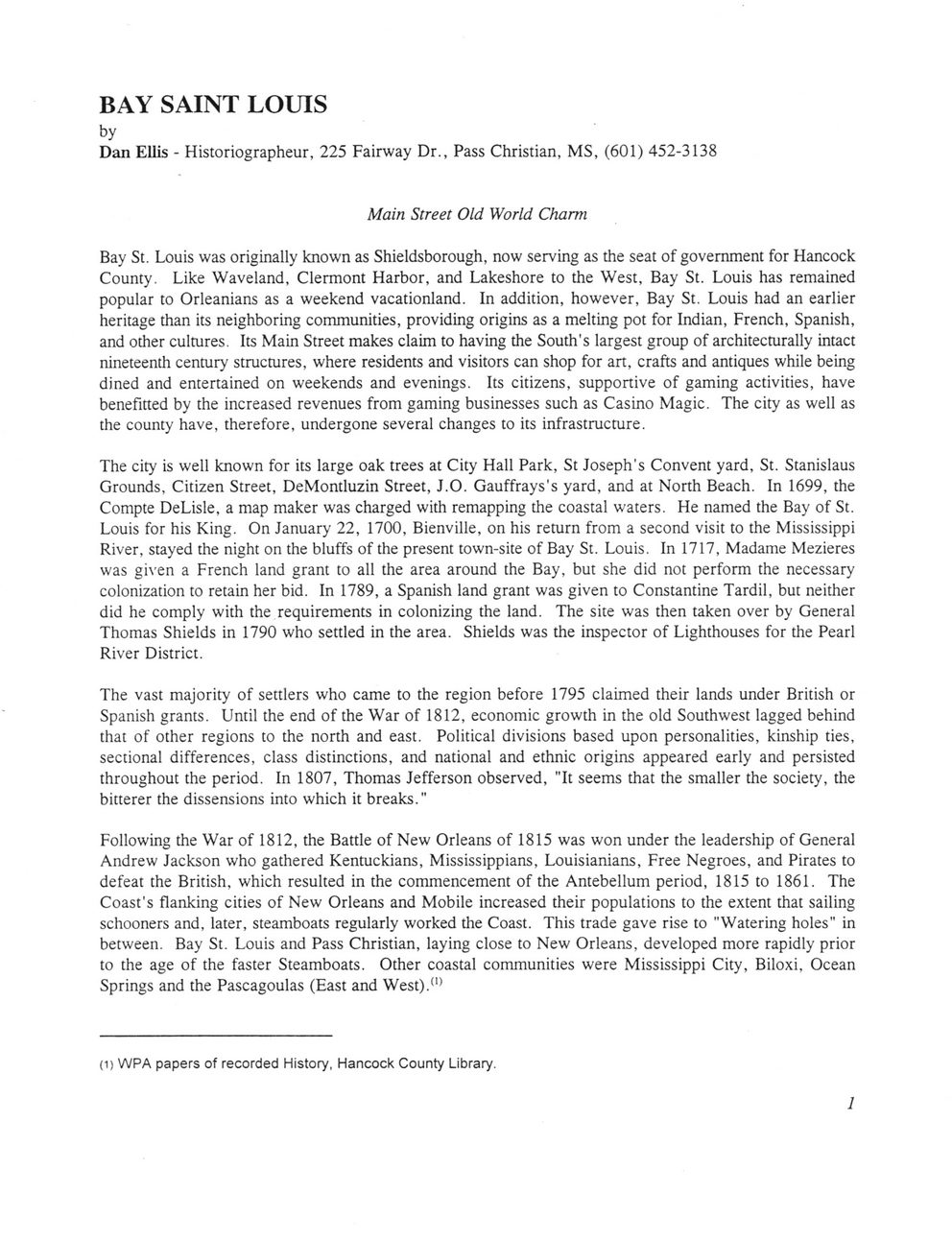This text was obtained via automated optical character recognition.
It has not been edited and may therefore contain several errors.
BAY SAINT LOUIS by Dan Ellis - Historiographeur, 225 Fairway Dr., Pass Christian, MS, (601) 452-3138 Main Street Old World Charm Bay St. Louis was originally known as Shieldsborough, now serving as the seat of government for Hancock County. Like Waveland, Clermont Harbor, and Lakeshore to the West, Bay St. Louis has remained popular to Orleanians as a weekend vacationland. In addition, however, Bay St. Louis had an earlier heritage than its neighboring communities, providing origins as a melting pot for Indian, French, Spanish, and other cultures. Its Main Street makes claim to having the South's largest group of architecturally intact nineteenth century structures, where residents and visitors can shop for art, crafts and antiques while being dined and entertained on weekends and evenings. Its citizens, supportive of gaming activities, have benefitted by the increased revenues from gaming businesses such as Casino Magic. The city as well as the county have, therefore, undergone several changes to its infrastructure. The city is well known for its large oak trees at City Hall Park, St Joseph?s Convent yard, St. Stanislaus Grounds, Citizen Street, DeMontluzin Street, J.O. Gauffrays's yard, and at North Beach. In 1699, the Compte DeLisle, a map maker was charged with remapping the coastal waters. He named the Bay of St. Louis for his King. On January 22, 1700, Bienville, on his return from a second visit to the Mississippi River, stayed the night on the bluffs of the present town-site of Bay St. Louis. In 1717, Madame Mezieres was given a French land grant to all the area around the Bay, but she did not perform the necessary colonization to retain her bid. In 1789, a Spanish land grant was given to Constantine Tardil, but neither did he comply with the requirements in colonizing the land. The site was then taken over by General Thomas Shields in 1790 who settled in the area. Shields was the inspector of Lighthouses for the Pearl River District. The vast majority of settlers who came to the region before 1795 claimed their lands under British or Spanish grants. Until the end of the War of 1812, economic growth in the old Southwest lagged behind that of other regions to the north and east. Political divisions based upon personalities, kinship ties, sectional differences, class distinctions, and national and ethnic origins appeared early and persisted throughout the period. In 1807, Thomas Jefferson observed, "It seems that the smaller the society, the bitterer the dissensions into which it breaks." Following the War of 1812, the Battle of New Orleans of 1815 was won under the leadership of General Andrew Jackson who gathered Kentuckians, Mississippians, Louisianians, Free Negroes, and Pirates to defeat the British, which resulted in the commencement of the Antebellum period, 1815 to 1861. The Coast's flanking cities of New Orleans and Mobile increased their populations to the extent that sailing schooners and, later, steamboats regularly worked the Coast. This trade gave rise to "Watering holes" in between. Bay St. Louis and Pass Christian, laying close to New Orleans, developed more rapidly prior to the age of the faster Steamboats. Other coastal communities were Mississippi City, Biloxi, Ocean Springs and the Pascagoulas (East and West).(1) (1) WPA papers of recorded History, Hancock County Library. 1

Ellis, Dan 001